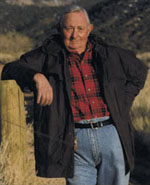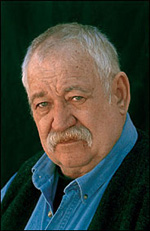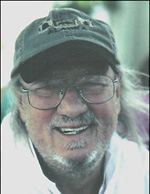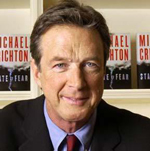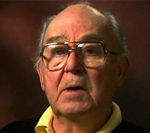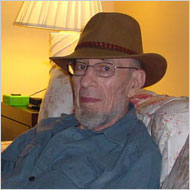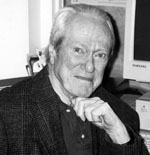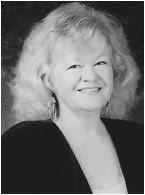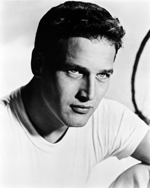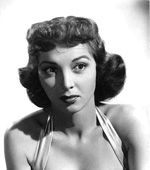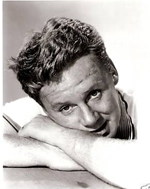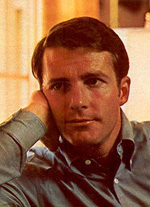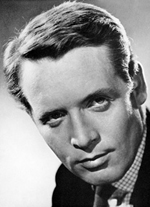IN MEMORIAM
The last few months of 2008 were particularly hard on the mystery-writing community. In that short span of time, we lost eleven eminent crime writers, including six Edgar-winners, one Dagger-winner, two Spur-winners, three MWA Grand Masters, one IACP Hammett-winner, one Grand Prix de Littérature Policière winner , one Macavity-winner, one Anthony-winner, one Agatha winner, one PWA “Eye” recipient, two Owen Wister Award-winners, one Ellery Queen's Readers Award-winner, two Oscar nominees, four MWA Past Presidents, and one former MWA Executive VP. All of them admired, respected, even loved by their brother and sister authors, to say nothing of their readers, and all passing to their final rewards between September and December. Any one of them would be sorely missed, but to lose so many in such a short time is particularly hard. (Jim Doherty)
Gregory Mcdonald (1937-2008) Born in Shrewsbury, MA, educated at Harvard, Gregory Mcdonald wrote his first novel, a non-criminous work called Running Scared (Oblensky, 1964) while still in his 20's. Following the publication of that book, he worked for several years as a writer for the Sunday magazine supplement of the Boston Globe , eventually leaving journalism to resume his career as a novelist. His second novel, and his first mystery, the classic Fletch (Bobbs-Merrill, 1974), made extensive use of his background in journalism, and introduced his most enduring series character, investigative reporter Irwin Maurice Fletcher. It was an immediate hit, and won Macdonald an Edgar for Best First Novel (at that time, the MWA required only that an entry in this category be the first mystery novel, not necessarily first novel ever). A year later the sequel, Confess, Fletch (Avon, 1976), appeared, and won the Edgar for Best Paperback Original, the only time two consecutive entries in a series have won back-to-back Edgars. Eight more Fletch novels appeared over the next dozen or so years, jumping back and forth chronologically, and making use of clever titles that sometimes indicated where the book fit in the internal timeline of the series. Fletch Won (Warner, 1985), for example, is the eighth book in the series, but the first chronologically, and the title is a pun of “Fletch One.” The ninth book in the series, Fletch Too (Warner, 1986), is the second chronologically, and has a title that is a pun of “Fletch Two.” Mcdonald would go on to develop several other series characters. Perhaps the most popular after Fletch himself was Boston Police Inspector Francis Xavier Flynn, an enigmatic cop who was introduced in Confess, Fletch , and went on to star in four novels of his own. Jack F. Faoni, purportedly Fletch's illegitimate offspring, co-starred with his supposed dad in Son of Fletch (Putnam, 1993) and went on to solo in Fletch Reflected (Putnam, 1994). Rural Tennessee slacker Skylar Whitfield headlined two novels from the mid-1990's. In between his series entries, Mcdonald would write stand-alones, straight novels, and non-fiction. In addition to his two Edgars, his colleagues in the MWA honored him by electing him to a term as the organization's president in 1985. Mcdonald was a master of pace, fast dialog, and humor. He will be sorely missed.
Tony Hillerman (1925 – 2008) Born in the Catholic mission community of Sacred Heart, Oklahoma , Tony Hillerman's playmates were mostly members of the Pottawatomie Indian tribe, and he received his elementary school education at St. Mary's Academy, a local Catholic boarding school for Indian girls. His respect for “original Americans” and for their culture, a quality that would later mark his fiction, can be traced to those early childhood connections. He graduated from high school in 1942. A year later, he entered the US Army, and was assigned to the European Theatre as part of the 103 rd Infantry. He was discharged in 1945, a certified war hero, having earned the Silver Star, the Bronze Star with Oak Leaf Cluster, and the Purple Heart. In 1948, he received a BA in Journalism from the University of Oklahoma, and from then until 1962, he worked at a number of different news organizations, including the Borger, TX, News-Herald , the Lawton, OK, Morning Press-Constitution , the Oklahoma City and Santa Fe offices of United Press International, and the Santa Fe New Mexican . He left active journalism in 1963 to go back to school, earning a Master's in English at the University of New Mexico . In 1966, he joined the faculty of UNM's journalism school, teaching there until 1987. He was chairman of the department from 1976 to 1981. In the late 1960's he decided to give in to a long-time urge to write fiction. His ambition was to author a blockbuster political thriller featuring a journalist as the hero, but he felt that such a project might be too ambitious to start with. To develop his novelistic muscles, he wrote what he regarded as a more standard whodunit set in Northeastern Arizona 's huge Navajo Reservation. After many rejections (including one from an editor who advised him to “get rid of all that Indian stuff”), the manuscript was eventually bought by legendary mystery editor Joan Kahn at Harper, who, despite her favorable opinion, required him to do some rewriting, and in particular to beef up one character whom Ms. Kahn felt had great potential. The character was a Navajo Tribal Police Lieutenant named Joe Leaphorn. The book that introduced Leaphorn, The Blessing Way (Harper, 1970) became one of the best-received mysteries of the year, and was a runner-up for the Best First Novel Edgar. Encouraged by his success, Hillerman went back to write the political thriller he'd back-burnered while working on his “less ambitious” first novel. That book, The Fly on the Wall (Harper, 1971), won Hillerman his second Edgar nomination, this time for Best Novel. Hillerman returned to the Navajo Police, and to Leaphorn, for his third novel, Dance Hall of the Dead (Harper, 1973), which won him his third consecutive Edgar nomination; and this time, he took the top prize home. In 1987, following the publication of the French edition, Dance Hall of the Dead also won the Grand Prix de Littérature Policière , the only book, aside from Adam Hall's The Quiller Memorandum (Simon & Schuster, 1965), ever to win both awards. Still busy with his academic career, it would be five years before Leaphorn would return in Listening Woman (Harper, 1978), which pitted the stalwart cop against political terrorists, and won Hillerman his fourth consecutive Edgar nomination. After this third Leaphorn novel, Hillerman, motivated partly by a bad legal deal that clouded his rights to his character, decided to create a very different Navajo policeman for his next book. Officer Jim Chee, introduced in People of Darkness (Harper, 1980), was younger than Leaphorn, less sophisticated, more naïve, and much more traditional in his observance of Navajo beliefs and rituals. In fact, in addition to his law enforcement work, Chee was training to be a tribal singer, a sort of clergyman/healer according to the rites of the Navajo faith. Chee carried the ball in two more novels, The Dark Wind (Harper, 1982) and The Ghostway (Harper, 1984). For his seventh Navajo Police novel, Skinwalkers (Harper, 1986), Hillerman, having managed to wrest legal control of the Leaphorn character back, decided to team his two cops. Skinwalkers became his first New York Times best-seller, winning both an Anthony for Best Mystery Novel at the 1987 Bouchercon, and a Spur from the Western Writers of America for Best Western Novel, a double win that pointed up Hillerman's dual appeal. For the rest of the series, Leaphorn and Chee were always co-featured. Hillerman would write another eleven Navajo Police novels, including the Macavity-winner The Thief of Time (Harper, 1988), along with one stand-alone, Finding Moon (Harper, 1995). His last novel, The Shape Shifter (Harper, 2006), won him his second Spur. In addition to his mysteries, Hillerman wrote children's books like The Boy Who Made Dragon Fly (Harper, 1972), true crime books like The Great Taos Bank Robbery (UNM Press, 1973), travel books like Indian Country – America's Sacred Land (Northland, 1987), and an Agatha-winning, Edgar-nominated autobiography, Seldom Disappointed (Harper, 2001). He also edited, or co-edited, crime fiction anthologies such as The Mysterious West (Harper, 1995) and The Best American Mystery Stories of the Century (Houghton Miflin, 2000). Along the way he'd be elected to a term as MWA's president, inducted into the Oklahoma Hall of Fame, and named an MWA Grand Master for Lifetime Achievement as a mystery writer. Just months before his death, WWA followed suit, presenting him with the Owen Wister Award for Lifetime Achievement in western writing. A devout Catholic his whole life, Hillerman had great respect for faiths other than his own, and had a unique ability to present alternate religious views with sympathy and dignity. This quality came through in his writing. Of all the awards he won or was nominated for in his career, the one he probably took the greatest pride in was being named, in 1987, a “Special Friend of The People” by the Navajo Tribal Council. Hillerman's status as a best-selling author, a level of success that made him one of the wealthiest men in New Mexico , did not cause him to forget his beginnings as a struggling novelist. In an effort to help aspiring authors, he established a competition for unpublished short story writers and novelists. That competition is now in its sixth year. Those who were privileged to meet Hillerman knew what a thoroughly genuine and unpretentiously nice man he was. He was precisely the person he seemed to be. The term “Christian gentleman” is a not used much anymore. It suggests, not only that a man so described has in abundance the qualities of kindness, modesty, courtesy, and integrity that make a true gentleman, but that these qualities grow out of his deep religious faith. Tony Hillerman was the epitome of a Christian gentleman.
James Crumley (1939 – 2008) The son of an oil field supervisor and a waitress, James Crumley grew up in South Texas . An “A” student in high school, he won a scholarship to the Georgia Institute of Technology, but left in 1958 to enlist in the Army, serving in the Philippines until 1961. After his discharge, he completed his education, earning a BA in History from Texas A&I and an MFA with an emphasis in creative writing from the University of Iowa . His master's thesis would eventually become his first book, One to Count Cadence (Random, 1969), a military novel that arguably did for the Vietnam War what James Jones's From Here to Eternity (Scribner's, 1951) did for WW2. Shortly after graduating, he obtained a position on the English faculty of the University of Montana at Missoula . Crumley had never been a fan of crime fiction, but, on the recommendation of Montana poet Richard Hugo, he tried Raymond Chandler. Impressed by Chandler 's work and that of Chandler disciple Ross Macdonald, Crumley tried his hand at his own hard-boiled private eye story. The result was The Wrong Case (Random, 1975), which introduced redneck Montana PI Milo Milodragovitch. He followed this up with what is probably his best remembered book, The Last Good Kiss (Random, 1978), in which C.W. Sughrue, another private eye from Meriweather , MT , made his debut. The two characters are similar in many ways, but Sughrue is harder, tougher, and has a mean streak that the fundamentally kindly Milo lacks. As Crumley put it, “ Milo is my good side, Sughrue's the bad.” Crumley would eventually write two more books about Milo, the Shamus-nominated Dancing Bear (Random, 1983) and The Final Country (Mysterious, 2001); and two more about Sughrue, The Mexican Tree Duck (Mysterious, 1993), which won the Dashiell Hammett Award from the International Association of Crime Writers, and The Right Madness (Viking, 2005), which won the Silver Dagger from the British Crime Writers Association. In Bordersnakes (Mysterious, 1996), the two detectives work together on the same case. He'd also write two short story collections and contribute a chapter to the comical round-robin mystery novel, The Putt at the End of the World (Grand Central, 2001). In nearly forty years as a published writer, Crumley only wrote eight novels, enough short stories to fill two more books, and one collaborative novel. Perhaps because he was not particularly prolific, he never quite achieved major mainstream success. But he had an unusually strong cult following, particularly among other writers. He brought to his work an original voice, a vivid prose style, and a strong sense of place (he was one of the first regional private eye writers). His two private eye characters, Milo and Sughrue, are the products of a first-rate creative mind. Perhaps, like many writers, his greatest success will come with his passing.
Fred Grove (1913 – 2008) A prolific, award-winning writer of traditional western novels, Fred Grove would also write four crime novels set during the Prohibition era, all of them growing out of the same childhood trauma. His first novel, Flame of the Osage (Popular Library, 1958), one of his last novels, The Years of Fear (Five Star, 2002), and two novels appearing about half-way through his career, Warrior Road (Doubleday, 1974) and Drums Without Warriors (Doubleday, 1976), all fictionalized different aspects of the infamous Osage Indian Murder Case, in which members of the Osage tribe were ruthlessly murdered by greed-crazed killers seeking to gain control of their oil rights. This case became the FBI's first high-profile investigation. He'd later call The Years of Fear his favorite, and most personal, of all his novels. Grove, Osage on his mother's side, was 10 years old when, while spending the night with relatives in Fairfax , OK , he was awakened by an explosion. A bomb had been planted underneath the home of the Smith family, killing Bill Smith, his oil-wealthy Osage wife, Rita, and their live-in maid, Nettie Brookshire. This was the most brazen in the years-long series of Osage murders, but its very brazenness gave the FBI agents working the case the clues they needed to break it. Like many novelists, Grove apprenticed as a newspaperman. In fact, having earned a BA in Journalism from the University of Oklahoma in 1937, Grove's original ambition was not to be a fiction writer, but a sportswriter. Sports would eventually form a big part of his western stories. It was while working as a reporter in the years immediately following WW2 that he met Tom White, who had been the FBI's lead investigator on the Osage case. They worked together on a non-fiction book about the case, but were unable to find a publisher. “It was very discouraging,” Grove would later say. “I spent a year reading state newspapers on microfilm.” Ultimately, the research would not be in vain. Grove would use it for the novels that would eventually form his “Osage Murders” tetralogy. He sold his first short story in 1951 and continued to write short fiction throughout his career. He became known for stories about Indians during the frontier period, and particularly for stories about the Indian Wars; and for fiction dealing with his favorite sport, quarter horse racing. He would eventually write over 30 novels, and enough short stories to fill several books. He was greatly esteemed by his fellow writers and his colleagues in the Western Writers of America would award five Spurs to him during his career. Comanche Captives (Ballantine, 1961), The Great Horse Race (Doubleday, 1977), and Match Race (Doubleday, 1981), all won for Best Western Novel, while “Comanche Woman” ( WWA Anthology , Avon, 1963) and “When the Caballos Came” ( Boys' Life , Nov. 1968) won for Best Western Short Story. In 1963, he'd also win the WWA Levi Strauss Saddleman Award for Lifetime Achievement. When Levi Strauss withdrew its sponsorship, WWA's trophy for Lifetime Achievement was renamed the Owen Wister Award, and Grove is often retroactively listed as a Wister Award winner. In addition, he'd win two Western Heritage Awards from the Cowboy Hall of Fame for the short story “Comanche Son” ( Boys' Life , Mar. 1961) and the novel The Buffalo Runners (Doubleday, 1968). A traditional western writer, he was, nevertheless, difficult to pigeonhole. He was versatile enough that, within the framework of the standard frontier novel, he could write tongue-in-cheek comedy, military novels, and sports novels. Few writers were as well-respected by their colleagues as Fred Grove. Few deserved it as much as Fred Grove did.
George C. Chesbro (1940 – 2008) The creator of “dwarf detective” Robert “Mongo” Frederickson, professor of criminology and licensed private eye, George C. Chesbro was born in Washington, DC, and spent most of his childhood in Delmar, New York. After graduating from Syracuse University with a degree in Special Education, he began working with troubled teens. He'd begun writing while still in college, but, for seven years, failed to sell anything until a small literary publication bought a poem of his for one dollar. His first crime story, “Snake in the Tower,” appeared in the March 1969 issue of Alfred Hitchcock's Mystery Magazine . For the next couple of years, he'd continue to place short fiction in AHMM and in sci-fi publications like The Magazine of Fantasy and Science Fiction and Worlds of If . One day, having taken note of the prevalence of disabled sleuths on television, like wheelchair-bound policeman Bob Ironside, blind insurance investigator Mike Longstreet, and overweight private eye Frank Cannon, Chesbro whimsically conceived of a detective who was a dwarf. He began a satirical story about the diminutive sleuth, largely to purge himself of a notion that he regarded as rather absurd and silly, but, as he later put it, “Halfway through, I discovered a key to the man's character was a simple quest to be taken seriously, for dignity. That touched me, and I started over again, this time doing it ‘straight' (or as straight as I'm able). I gave Mongo dignity, and in return he gave me a career.” That rewritten story, “The Drop,” was eventually published in the October 1971 issue of Mike Shayne Mystery Magazine . It introduced Dr. Robert Frederickson, Ph.D., who, prior to starting his career as an educator and private detective, had been famous as the midget circus acrobat “Mongo the Magnificent.” Over the next six years, eight more stories appeared in both AHMM and MSMM. In the meantime, he wrote his first novel, an espionage thriller called King's Gambit (NEL, 1976). Though it would not be published in the US for more than 30 years, UK and foreign sales encouraged Chesbro to try a book-length adventure of Mongo. The first Mongo novel, Shadow of a Broken Man (Simon & Schuster, 1977), appeared the following year. Fourteen more novels, and one collection of short stories, followed. Aside from Mongo, Chesbro created two other series characters, mercenary warrior and con man Chant Sinclair for a trilogy of novels written as by “David Cross,” and psychic former CIA agent Veil Kendry under his own name, managing to fit in a half-dozen stand-alones and/or film novelizations as well. In addition, Mongo's police contact, NYPD Lieutenant Garth Frederickson, who just happens to be Mongo's big brother (and in this case, “big” is meant literally as well as figuratively, since Garth is a strapping six-two), retired from the force, got his own PI license, and was spun off into a series of short stories that appeared in Ellery Queen's Mystery Magazine . One of these, “The Problem with Pigs” ( EQMM , June 1997), won the Ellery Queen Readers Award for that year. But it was the novels and stories featuring Mongo himself that were Chesbro's most popular works. Aside from the unusual notion of a dwarf who was a professional detective, the series would become noted for its unabashed exploration of occult and science-fictional elements rarely seen in private eye stories. The third Mongo novel, An Affair of Sorcerers (Simon & Schuster, 1979), involved the detective with witchcraft and dark forces. The fourth, The Beasts of Valhalla (Atheneum, 1985), had him investigating a case that hinged on hideous DNA experiments. And from that point, the Mongo series would, as a reviewer in Playboy put it, all seem to be constructed along the lines of “Raymond Chandler meets Stephen King by way of Alice 's looking glass.” When the Mongo series went out of print, Chesbro took the unusual step of getting the rights back and forming his own publishing house, Apache Beach Publications, to reprint them. APB has published new editions of all the Mongo novels except for the most recent, Lord of Ice and Loneliness , which was recently published in France as Le Seigneur des Glaces et de la Solitude (Rivages, 2006) , but is not yet available in the US. Active as a mystery writer, Chesbro was also active in the mystery community. He served for four years on the MWA National Board, and three as MWA's executive vice-president (the EVP is the actual workhorse of the organization; the presidency being a largely honorary title). Chesbro's work is marked by imagination, boldness, and something every successful writer needs in abundance. Perseverance. Most people would give up if they'd only made one dollar in seven years of writing. Chesbro kept at it, and, because of his refusal to give up, created one of the most memorable private eye characters in fiction.
Michael Crichton (1942 – 2008) Novelist, physician, filmmaker, educator, political and scientific commentator, Michael Crichton was perhaps most identified with science-fiction, thank to best-selling novels like The Andromeda Strain (Knopf, 1969) and Jurassic Park (Knopf, 1990), but a substantial segment of his work, both in prose and in film, was in our genre. He began his writing career in his early 20's, with a number of paperback original crime thrillers, written under the pseudonym of “John Lange,” such as Odds On (Signet, 1966), a caper novel about the attempted robbery of a high-end hotel, and Scratch One (Signet, 1967), an espionage thriller about an ordinary guy inadvertently caught between the CIA and a gang of arms smugglers and international terrorists. While still a student at Harvard Medical School, Crichton wrote what would become his first hardback novel, a medical whodunit titled A Case of Need (World, 1968), which was published (under the pseudonym “Jeffrey Hudson”) to wide acclaim, winning him his first Edgar Award, in the Best Novel category. His breakout novel, The Andromeda Strain , the first novel to appear under his own name, was published the following year, and established his most common theme, scientific advancement going wrong, despite a complex system of built-in safeguards, resulting in worst-case scenarios. The same year that The Andromeda Strain appeared, Crichton graduated from medical school and began a post-doctoral fellowship study at the Salk Institute. At the same time, he was continuing to write novels, hard-covers under his own name, and soft-covers as “Lange.” His penultimate “Lange” novel, Grave Descend (Signet, 1970), won him a second Edgar nomination, in the Paperback Original category. Over the years, as he became more and more identified with science fiction, Crichton would nevertheless continue to be active in our genre, writing crime novels like The Great Train Robbery (Knopf, 1975), a Victorian caper novel fictionalizing an actual 1855 train robbery; Rising Sun (Knopf, 1992), an LA-based police procedural that derives its plot from the increasing encroachment of Japanese industry into the US economy; and State of Fear (HarperCollins, 2004), a techno-thriller about eco-terrorists that questions the conventional wisdom about global warming. During this time, Crichton also became heavily involved in filmmaking, particularly of adaptations of his own books. Among other screen projects, he directed the TV-movie Pursuit (ABC, 1972), based on his final “Lange” novel Binary (Knopf, 1972); directed Westworld (MGM, 1973) from his own original screenplay; and wrote the script for the film version of The Great Train Robbery (UA, 1979), winning his third Edgar nomination, and his second Edgar, in the Best Screenplay category. Making use of his background as a physician, he also created, wrote scripts for, and served as the executive producer of the long-running medical TV drama ER (NBC, 1994 – Present). After the announcement of Crichton's death, his long-time friend, filmmaker Stephen Spielberg, said, “ Michael's talent outscaled even his own dinosaurs of Jurassic Park . He was the greatest at blending science with big theatrical concepts, which is what gave credibility to dinosaurs again walking the earth . . . There is no one in the wings that will ever take his place. ”
John Michael Hayes (1919 – 2008) Prolific film and television writer John Michael Hayes began his writing career in newspapers, breaking into show business (after a stint of WW2 military duty) by providing scripts for radio crime dramas like Suspense , Johnny Dollar , Inner Sanctum , and Sam Spade . His first screenwriting credit was Red Ball Express (Universal, 1952), dramatizing the battlefield heroism of Army truck drivers, including black soldiers, during World War II. A series of “A” picture assignments, including Thunder Bay (Universal, 1953), starring James Stewart (the first of three Hayes-written films Stewart would appear in), led to his being personally chosen by Alfred Hitchcock to write the screen adaptation of Cornell Woolrich's short story “It Had To Be Murder” ( Dime Detective , Feb. 1942). The resulting film, Rear Window ( Paramount , 1954), was a milestone in the careers of both screenwriter and director. Both would be nominated for Oscars for their work on the film, and Hayes would win an Edgar for Best Mystery Screenplay. Hitchcock and Hayes would collaborate three more times, on To Catch a Thief ( Paramount , 1955), The Trouble with Harry ( Paramount , 1955), and the remake of The Man Who Knew Too Much ( Paramount , 1956), but then parted company over a credit dispute. Hayes, as if to prove he didn't need Hitchcock, would win another Oscar nomination for his work on his next film, Peyton Place (20 th /Fox, 1957), one of the most successful films of the 1950's. Gaining a reputation as a versatile writer, he would, over the next few years, be chosen to write comedies like The Matchmaker ( Paramount , 1958), heavy dramas like The Children's Hour (UA, 1961), and potboilers like The Carpetbaggers ( Paramount , 1964). Less prolific after the mid-1960's, Hayes returned to our genre when he collaborated with Mort Briskin and Stephen Downing on the script for the fact-based rural police drama Walking Tall (Bing Crosby Productions, 1973), though he would decide not to take an on-screen credit for that work. This was followed by a script for the TV-movie Winter Kill (ABC, 1974) on which he collaborated with another Edgar-winning screenwriter, David Karp. The film featured Andy Griffith as the police chief of a small resort community, and it led to a short-lived TV series, Adams of Eagle Lake (ABC, 1975), which lasted only two episodes. This was Hayes's last work in our genre. In 2004, the Screen Writers Guild would award Hayes their highest honor, the Screen Laurel Award for Lifetime Achievement. A fitting capstone to a remarkable film and broadcast career.
Julius Fast (1919 – 2008) Part of a family of authors, Julius Fast was the younger brother of best-selling novelist Howard Fast, and the uncle of science-fiction writer Jonathan Fast. A pre-med major before entering military service, Julius's first novel, Watchful at Night (Rinehart, 1945), written while he was still a sergeant in the US Army Medical Corps, made crime fiction history when it became the first book to win an Edgar from the Mystery Writers of America. At that inaugural MWA awards ceremony, Julius's book was named Best First Mystery Novel of the Year, at that time the only prose fiction category, since there would be no award for short fiction until 1947, and none for Best Mystery Novel until 1953. Not surprisingly, given its wartime conception and Julius's own experience and education, Watchful at Night had both a military and a medical background. A key scene is a postmortem examination conducted by an Army pathologist. This would set a minor MWA tradition of mysteries that included authentically described autopsies winning Edgars, and Julius Fast can be said to have paved the way for writers like Lawrence G. Blochman, John Feegel, Tony Lawrence and Lou Shaw, Patricia Cornwell, Paul Brown, and John Milne, who would all win Edgars for mysteries featuring crime-solving forensic pathologists. In the ensuing years, Fast would continue to write mysteries, including Walk in Shadow (Rinehart, 1947) and A Model for Murder (Rinehart, 1956), but his major efforts would be in the field of non-fiction, producing books on everything from sexuality to health to celebrity biographies. Ironically, as Julius made a name for himself as a quick, reliable writer of non-fiction to order on a wide variety of subjects, it was his brother, Howard, the “serious novelist,” who, in the guise of “E.V. Cunningham,” became the more prolific crime writer.
Hillary Waugh (1920 – 2008) Born and raised in New Haven , CT , Waugh, whose youthful ambitions included being a cartoonist and a song writer, but not a novelist, graduated from Yale in 1942 with a degree in art and a minor in music, then immediately entered the Navy for training as an aviator. During this stint of military duty, Ensign Waugh, inspired by writers like Ellery Queen and S.S. Van Dine, started a mystery novel. By the time he left the service in 1946, he'd completed two drafts. That novel, Madam Will Not Dine Tonight (Coward-McCann, 1947), appeared the following year. It featured Sheridan Wesley, a tough but light-hearted private eye. Two more Wesley books followed in 1948 and 1949. On 6 September 1949, shortly after delivering the manuscript for his third book, Waugh took the first step to a major career epiphany when he spent two bits on a copy of a modest paperback original by Charles Boswell called They All Died Young (Handi-Books, 1949), which collected a number of Boswell's true-crime articles from magazines like Startling Detective and True Police Cases . Each chapter told the story of a police investigation into the murder of a “comely young woman.” Waugh found himself bowled over by the impact of these true-crime accounts. “The striking quality,” he later wrote, “was their ring of authenticity.” He immediately lost interest in continuing what he described as “light, thin, pseudo-tough entertainments.” Instead he wanted to try something different. “I wanted to turn out a book that would hit the reader with the same kind of wallop these tales had dealt to me.” Inspired by one particular case, the unsolved 1946 disappearance of a young Bennington College undergrad named Paula Weldon, he began a concentrated course of research into how such a disappearance would be handled by the police force of a small college town. His fiancé, Diana Taylor, was a freshman at Smith College in Northampton , MA , at the time, which made it the most convenient place to begin his research. Enlisting the cooperation of the Northampton Police, he found out precisely how such a disappearance would be investigated. Pleasantly surprised to discover that the cops were so graciously cooperative, Waugh said, “All kinds of fascinating tidbits came tumbling forth, including the tales of real disappearances from Smith (they happen at every girls' college) – some with tragic endings, some not.” Fictionalizing Smith College into “Parker College,” and the town of Northampton, MA, into “Bristol, MA,” and loosely modeling his protagonist, Police Chief Frank Ford, on Northampton's actual police chief, Waugh sat down to write. Soon the manuscript, titled Last Seen Wearing… , was ready for submission. A condensed short story version appeared in the March 1952 issue of Cosmopolitan . The book-length version was published by Doubleday a few months later. Without realizing it, Waugh had become part of a slowly building movement among crime fiction writers to present police work as accurately as possible. The radio series Dragnet had debuted in 1949, the same year Waugh stumbled across Boswell's true-crime book. Sidney Kingsley's stage play, Detective Story , opened on Broadway the same year. Movies like The Naked City (Universal, 1948), He Walked by Night (Eagle-Lion, 1948), and The Blue Lamp (Ealing 1950), dubbed “semi-documentaries” by film critics, all dramatized real-life criminal cases with the cooperation of the actual police agencies involved. Novelists like Lawrence Treat, Ben Benson, Maurice Procter, and MacKinlay Kantor were all writing novels based on the authentic depiction of law enforcement. The term “police procedural” would not be coined for several years, but when it was, Hillary Waugh would be recognized as one of the pioneers of the form, and Last Seen Wearing … as one of the finest examples. Waugh followed up with another stand-alone cop novel, A Rag and a Bone (Doubleday, 1954). He'd considered writing another novel about Frank Ford, but decided that the character “if forced to perform in [the] straitjacket,” of a continuing series, “would lose the spontaneity and crustiness that had characterized him. I feared he would degenerate, as Falstaff did, if forced to overperform.” Instead, for series use, he created a similar, but not identical character, named Fred C. Fellows, the police chief of “Stockford, CT,” which, we may infer, is a fictionalized version of either Guilford, CT, where Waugh lived for many years and served as first selectman (roughly comparable to a mayor) in the early 1970's; Branford, CT, where he worked as a small-town newspaper editor; or was perhaps a composite of the two. Fellows, somewhat younger than Ford, considerably more affable, was deliberately designed to be more suited for repeat performances. He debuted in Sleep Long, My Love (Doubleday, 1959), and would go on to headline another eleven novels. As the police procedural became more widely recognized as a distinct mystery sub-genre, Waugh seemed to have the field of rural cop fiction almost entirely to himself. In 1968, the same year that the last Fellows novel appeared, Waugh introduced a new cop protagonist, a distinctly urban protagonist, NYPD Homicide Detective Frank Sessions, who made his first appearance in “30” Manhattan East (Doubleday, 1968). Two more Sessions novels followed. Though identified with the police procedural, Waugh wrote widely in other sub-genres as well. He returned to the private eye story with a Marlowe-ish character named Simon Kaye, introduced in The Glenna Powers Case (Raven House, 1980), and going on to star in another five novels. He also wrote courtroom thrillers like Parrish for the Defense (Doubleday, 1974), books about a crime-solving journalist named Dave Halliday under the pseudonym of “H. Baldwin Taylor,” and even gothic suspense novels under the feminine persona of “Elissa Glendower.” He'd return to the rural procedural for his last novel, A Death in a Town (Carroll & Graf, 1988). His final work, a non-fiction textbook for aspiring crime writers, Hillary Waugh's Guide to Mysteries and Mystery Writing (Writers Digest Books, 1991), garnered him an Edgar nomination in the Best Critical/Biographical category. Though he never won an Edgar for an individual work (we can speculate that Last Seen Wearing… might have won had there been an award for “Best Novel” in 1952, but that category wasn't introduced until 1953), he did receive MWA's two greatest honors. After many years of service on the national board, he was elected president of the organization in 1973. And, in 1989, he was given the Grand Master award for Lifetime Achievement. A fitting honor for a prolific writer of consistently high-quality novels in a variety of sub-genres. He earned the award, of course, for the entire body of his work, but, given the impact of Last Seen Wearing . . . , it's safe to say that, had he never written any other novel, he'd still have deserved to be named a Grand Master.
Meg O'Brien (died 6 Dec. 2008 ) Mother of five children and grandmother of four grandchildren, Ms. O'Brien was born and raised in a Baptist home in New Jersey, but converted to Catholicism at the age of 14 and immediately joined the Order of the Sisters of St. Joseph as a postulant. Within a year and a half, she found that the vocation did not suit her and left the convent (“leapt over the wall,” as she later put it), long before taking her final vows. Many years later, after a variety of jobs, and after having raised four of her five children to adulthood, she found herself on welfare, while still responsible for providing for her youngest child. She had always had it in the back of her mind to write “someday.” Her daughter's needing a new pair of skates was the impetus behind her finally taking that ambition off the back-burner. In terms of immediately improving her and her daughter's financial situation, this was not, at least in the short term, a good decision. But in the long term, it led to a successful five book series featuring free-lance investigative journalist and gangster's squeeze Jessica “Jesse” James, a two-book series featuring abused women's counselor Abby Northrup, and eleven stand-alone thrillers, all featuring strong female protagonists. Jessica James was introduced in The Daphne Decisions (Bantam, 1990). Abby Northrup made her debut in Sacred Trust (MIRA, 2000). Ms. O'Brien's first stand-alone suspense thriller was The Keeper (Doubleday, 1992). Throughout her career as a novelist, she dealt with serious issues like spousal abuse, child molestation, substance addiction, and political corruption. Her vivid characters, sense of pace, and strong story-telling ability won her top reviews and a loyal readership. Her tragic death, years before her time, occurred while she was in intensive care, following a heart operation. The staff of Mysterical-E extend their deepest sympathies to her family.
Donald E. Westlake (1933 – 2008) One of the most versatile mystery writers in the history of the genre, a winner of multiple awards, a titan of productivity whose total number of books reached triple digits years ago, saying Donald Westlake had a truly remarkable career would be a masterpiece of understatement. Westlake developed the ambition to be a writer very early in life. “When I was 11 years old,” he later said, “I wrote a story about a gang killing in a nightclub. There wasn't a word in that story that I understood. Writers are always told to write what they know, but at 11 you don't know anything except the movies and books you've seen and read.” He then set himself a goal of being paid and published for a piece of fiction while still in his teens. He missed that goal by a single year, making his first sale came at the age of 20. While working at a literary agency, he continued to write short stories as well as soft-porn novels under a variety of house names, honing his craft through the 1950's. His first crime novel, The Mercenaries (Random, 1960), was an inside look at organized crime from the point of view of a high-level mobster, anticipating books like Mario Puzo's The Godfather (Putnam, 1969) by nearly a decade. It won him his first Edgar nomination, in the First Novel category. He followed up with several more excellent, but fairly standard, hard-boiled crime novels, including Killing Time (Random, 1961), a book reminiscent of Hammett's Red Harvest (Knopf, 1928) in its plot involving a town-taming private eye; 361 (Random, 1962), a revenge novel; and Pity Him Afterwards (Random, 1964), about a murderous fugitive from a state hospital for the criminally insane pursued by a small-town cop. For his sixth crime novel, Westlake decided to try something different. The Fugitive Pigeon (Random, 1965) was deliberately comical. Westlake was advised against trying this approach because, he was told, comedy doesn't translate well, and, consequently, foreign sales would suffer. Still, he was proving to be fairly productive, and decided he could afford this one foray into comedy just to get it out of his system. Instead, it turned out to be a career-changer. For the rest of his life Westlake 's name was identified with comical mystery romps, transforming him, in the words of one critic, into “the Neil Simon of the crime novel.” His second comic crime novel, The Busy Body (Random, 1966) earned him his second Edgar nomination, for Best Novel. Notwithstanding his developing identification as a mystery humorist, Westlake had already developed another persona with which he was keeping his serious hard-boiled chops well-honed. The pseudonym “Richard Stark” had been conceived primarily as a way of allowing the prolific Westlake to get more than one book published a year. Under that name, he had written an ultra-tough gangster novel about a professional armed robber named Parker called The Hunter (Pocket, 1962). It originally ended with the unrepentantly vicious criminal getting killed, but his editor liked it so much, he asked Westlake to change the ending so that it could be developed into the first of a series. Parker, an unabashedly ruthless criminal who was willing to kill anyone, man, woman, or child, who got in his way, was no “gentleman thief” in the tradition of E.W. Hornung's Raffles, nor a modern-day Robin Hood who only stole from criminals to help the innocent in the tradition of Leslie Charteris's The Saint. He was thug, plain and simple, a character out of a W.R. Burnett novel like High Sierra (Knopf, 1940) or The Asphalt Jungle (Knopf, 1949). Except that he always got away with it at the end of the book. Yet, as unlikely as it seems, the rigorously unsympathetic, unsentimental Parker became Westlake 's first series character. Well, almost his first. In the late ‘50's, he'd started a series of short stories about a middle-aged Brooklyn cop named Abe Levine who suffered from a bad ticker, but Parker was the first series character developed for novel-length work. More about Levine later. While he continued to turn out comic crime novels under his own name, he'd alternate them with diamond-hard gangster novels featuring Parker as Stark. The Hunter was followed by The Mourner (Pocket, 1963), The Outfit (Pocket, 1963), and The Man with the Getaway Face (Pocket, 1963). He was also starting to make film sales. A movie version of The Busy Body ( Paramount , 1967) starred Sid Caesar. Within a few months, Point Blank (MGM, 1967), a film version of The Hunter starring Lee Marvin, was also released. That same year the fourth of his comical crime novels, God Save the Mark (Random, 1967) was published. It would go on to win Westlake his first Edgar, in the Best Novel category. But, as popular as Westlake the humorist was getting to be, it was Stark the gangster writer who was proving the most successful, particularly as source material for movies. Following Point Blank , Jim Brown played the Parker figure in The Split (MGM, 1968), a movie based on Westlake 's seventh Parker novel, titled, appropriately enough, The Seventh (Pocket, 1966). In the meantime, a French version of The Jugger (Pocket, 1965) starring a woman in the Parker role, Made in USA ( Pathé , 1967), was being released in the US . Following the release of these movies, a friend of Westlake 's supposedly called him up and said, “So far your character Parker has been played by a white man, a black man, and a woman. I think he lacks definition.” Of course, as anyone who's read them knows, there are few characters in all of crime fiction as well-defined as Parker. Parker went on to get Westlake some more Edgar recognition when the twelfth book in the series, The Sour Lemon Score (Gold Medal, 1969), was nominated in a new category, Best Paperback Original Novel. The following year Westlake created another series character. He'd been trying to write a Parker novel in which the relentless gangster had to steal the same item over and over again. It was a good idea, but, Westlake discovered, it was too humorous for Parker. Wanting to keep the idea, but reluctant to make his hard-edged character seem ridiculous, he developed a comic doppelganger for Parker, an ingenious, but chronically unlucky master criminal named Dortmunder. Dortmunder debuted in The Hot Rock (Random, 1970), which won Westlake his fourth Edgar nomination, for Best Novel. A few years earlier, Westlake had also developed yet another series character, a publicly disgraced, clinically depressed ex-cop, eking out a living as an unlicensed private detective, named Mitch Tobin. Tobin debuted in Kinds of Love, Kinds of Death (Random, 1966), and would go on to headline another four novels, slowly coming to terms with his guilt and slowly learning to engage with the outside world. Since Tobin did not seem to be a comfortable fit for either the comical Westlake or the ultra-hard Parker, Westlake created yet another persona, “Tucker Coe,” for the series. Films were continuing to come out. A movie version of The Hot Rock (20 th /Fox, 1972), with Robert Redford as Dortmunder, won scriptwriter William Goldman an Edgar nomination in the screenplay category, and a film version of The Outfit (MGM, 1973) cast yet another actor, Robert Duvall, in the Parker role (though, curiously, not one of the films based on the Parker novels has ever used the name “Parker” for the lead character). Westlake was also continuing to develop new personas for different kinds of novels. “Curt Clark” for the science fiction/mystery hybrid Anarchaos (Ace, 1967); “Timothy J. Culver” for a political thriller, Ex Officio (M. Evans, 1970); “J. Morgan Cunningham” for a offbeat novel set in and around a public washroom in NYC's Bryant Park called Comfort Station (Signet, 1973); and “Samuel Holt” for a series about an amateur detective named, of all things, Sam Holt. Ever inventive, Westlake used several of these personas in an article that purported to be a panel discussion on contemporary crime fiction between Westlake, Stark, Coe, and Culver which appeared in Murder Ink (Workman, 1977) edited by Dilys Winn. Westlake diverged from his tightly formatted pattern with Kahawa (Mysterious, 1981), which, despite appearing under Westlake's own name, was a basically straightforward adventure story about stealing a whole freight train of valuable coffee from the murderous real-life dictator Idi Amin. It won Westlake yet another Edgar nomination, for Best Novel. A few years later, he gathered all those police procedural stories about the heart-diseased Brooklyn cop he'd written in the late ‘50's and early ‘60's into a single volume, Levine (Mysterious, 1984), and wrote one final Levine story that put an appropriate period to the series especially for the collection called “After I'm Gone.” It won him another Edgar nomination, his first in the Best Short Story category. The success of Westlake 's novels as film properties caused him to become sought after as a screenwriter. His first script was for a film adaptation his own novel, Cops and Robbers (M. Evans, 1972) released by UA in 1973. He was not entirely happy with the results, but it did get him a screen credit. A few years later he co-wrote the original screenplay for Hot Stuff ( Columbia , 1979), a screwball cop comedy. After that, he was tagged to write the script for the TV-movie Fatal Confession (NBC, 1987), featuring Tom Bosley as Ralph McInerny's clergyman/sleuth , Father Dowling. The film was successful enough to be turned into a series in 1989. The same year as the Father Dowling pilot, Westlake co-wrote, with Carolyn Lefocurt and Brian Garfield, the script for The Stepfather (New Century, 1987). The film was both a critical and a commercial success, and earned Westlake yet another Edgar nomination, his first in the Best Screenplay category. Dortmunder and his gang were continuing to be popular, and Westlake was able to work some inside jokes into the series. In Jimmy the Kid (M. Evans, 1974), for example, Dortmunder is persuaded, against his better judgment, to participate in a kidnapping caper, using as his blueprint for the crime a Parker novel by Richard Stark called Child Heist (which, by the way, isn't actually an entry in the series). Dortmunder also became the only one of Westlake 's series character that he used in short stories as well as novels. One of Westlake 's short Dortmunder capers, “Too Many Crooks” ( Playboy , Aug. 1989), finally won Westlake his second Edgar, in the Short Story category. All the Dortmunder short stories were reprinted in the collection Thieves' Dozen (Mysterious, 2004). A year after winning his Edgar for “Too Many Crook,” his script for The Grifters (Cineplex Odeon, 1990), adapted from Jim Thompson's novel (Regency, 1963), garnered him his first Oscar nomination, for Best Adapted Screenplay, and his third Edgar, for Best Mystery Screenplay. Westlake is one of only two writers (the other is Joe Gores) to win three Edgars in three different categories. More honors would come in the years following. In 1993, he'd be named an MWA Grand Master, a quadruple Edgar win that has yet to be matched. In 1996, he'd be elected to a term as MWA's president. A year later, his scathing look at corporate downsizing, The Ax (Mysterious, 1997), would win a Macavity nomination for Best Novel. In 2004, the Private Eye Writers of America would, on the strength of Killing Time and the Mitch Tobin series, award him “The Eye” for Lifetime Achievement. It was once said of Audie Murphy, the most decorated military serviceman in American history, that it was easier to name the awards he didn't win than to list all of those he did. The same might be said of Donald Westlake. What is even more remarkable than all the awards and nominations he acquired during his career is how richly each of them was deserved. What do all of Westlake 's books, stories, dramatic scripts, etc., have in common? Style, wit, razor-sharp perceptiveness, clean uncluttered prose, clean uncluttered plots, vivid characters? All of that and more, certainly. But perhaps Westlake himself is the best judge of what is the most important common element in all his works. “I believe,” he once wrote, “my subject is bewilderment. But I could be wrong.”
Aside from the distinguished group of mystery writers we lost during the last few months of the year, we also lost several fine actors who made significant contributions to our genre though their performances.
Paul Newman (1925-2008) Devastatingly handsome star of stage, screen, and television, screenwriter, film producer and director, race car driver, chef, philanthropist, and an extraordinarily fine actor to boot. His crime fiction roles include early live TV parts in mystery anthology shows like Suspense (CBS, 1949-54), The Web (CBS, 1950-54)), and Danger (CBS, 1950-55). In the 1955 Broadway production of The Desperate Hours he played hostage-taking escaped convict Glenn Griffin, the same part played by Humphrey Bogart in the film version (Paramount, 1956) and Mickey Rourke in the remake (MGM, 1990). Criminous film roles include a novelist innocently involved in a kidnapping plot during the Nobel ceremonies in The Prize (MGM, 1963), a scientist trying to smuggle valuable information from the Soviet Bloc in Torn Curtain (Universal, 1966), a British Intelligence agent in The Mackintosh Man (Warners, 1973), and a uniformed beat cop in Fort Apache – The Bronx (20 th /Fox, 1981). He also played Lew Harper, a slightly altered film version of Ross Macdonald's Lew Archer, in the Edgar-winning Harper (Warners, 1966) and the Edgar-nominated The Drowning Pool (Warners, 1975), as well as a very similar private eye named Harry Ross in Twilight (Paramount, 1998). He won an Oscar nomination for his portrayal of “Fast Eddie” Felson, a pool shark on the fringes of the criminal underworld in The Hustler (20 th /Fox, 1961), and actually won the little gold man when he repeated the role in the sequel, The Color of Money (Touchstone, 1986), more than two decades later. Felson is, arguably, his most significant role in our genre, but some might make a case for con man Harry Gondorf in the Oscar-winning The Sting (Universal, 1973), or Depression-era mobster John Rooney in the Oscar-nominated Road to Perdition (DreamWorks; 20 th /Fox, 2002), for which he won his ninth Oscar nomination for a film performance, and his first for a supporting role.
Beverly Garland (1926-2008) Lovely actress who, though perhaps best-remembered as the mom on the sitcom My Three Sons (ABC, 1960-65; CBS, 1965-72), specialized in playing tough, intelligent, feisty roles throughout her career. She made her debut, under her maiden name of Beverly Campbell, in the classic noir thriller D.O.A. (UA, 1950). A series of supporting parts, including many “B” crime melodramas like The Glass Web (Universal, 1953), The Miami Story (Columbia, 1954), Swamp Woman (AIP, 1955), New Orleans Uncensored (Columbia, 1955), and Sudden Danger (Allied Artists, 1955), followed. In later years, she was a frequent guest star on such crime programs as Perry Mason (CBS, 1957-66), State Trooper (Syndicated, 1956-59), Cain's Hundred (NBC, 1961-62), Ironside (NBC, 1967-75), and Mannix (CBS, 1967-75), and would win semi-regular parts as the mother of part-time secret agent Amanda King on Scarecrow and Mrs. King (CBS, 1983-87) and as the mother of private eye Laura Holt on Remington Steele (NBC, 1982-87). Perhaps her most significant role in our genre was as Detective “Casey” Jones of NYPD's Bureau of Policewomen in Decoy (Syndicated, 1957-59). Filmed on location in NYC, Decoy was a semi-documentary cop show firmly in the mold of Dragnet (NBC, 1951-59, 1967-70; ABC, 2003-04), and Mrs. Garland's character could be described as a distaff Joe Friday, tough, tenacious, compassionate, seemingly living for little aside from her work, at which she, like Friday, she was quietly but superlatively competent. Unlike Friday, she had no regular partner, and had to carry the show herself. She, and her character, were both up to the challenge. Like the characters she played, Beverly Garland was tough and tenacious, and she paved the way for many actresses who, in later times, with changing attitudes, had far greater success in the kinds of roles Mrs. Garland pioneered.
Van Johnson (1916-2008) Boyishly handsome leading man whose All-American looks made him ideal for romantic leads in musicals like Two Girls and a Sailor (MGM, 1944), Thrill of a Romance (MGM, 1945), and In the Good Old Summertime (MGM, 1949). The same boyish but determined features also made him a natural to play soldiers in military dramas like Thirty Seconds Over Tokyo (MGM, 1944), Battleground (MGM, 1949), Go for Broke! (MGM, 1951), The Caine Mutiny ( Columbia , 1954), and Men of the Fighting Lady (MGM, 1954), though, ironically, an injury from a traffic accident made him ineligible for military service in real life. In our genre he played, among other things, a blind, crime-solving playwright in 23 Paces to Baker Street (20 th /Fox, 1956), a smuggler operating behind the Iron Curtain in Action of the Tiger (MGM, 1957), a Nazi spy in The Last Blitzkrieg (Columbia, 1959), a wartime evacuee who returns to England to clear his father of a murder charge in Beyond This Place (Allied Artists, 1959), a wartime OSS agent in The Last General (Columbia, 1960), the pilot of a hijacked airliner in the TV-movie The Doomsday Flight (NBC, 1966), and a police captain on the trail of a hitman in Company of Killers (Universal, 1970). Possibly his most significant part in our genre was as tough, determined LAPD Homicide Lieutenant Mike Conovan in the fact-based, Edgar-nominated noir procedural Scene of the Crime (MGM, 1949). His show business career spanned more than a half-century, and his roles spanned an unusually broad spectrum. He was one of the most durable, reliable stars in Hollywood , and, by most accounts, a thorough professional, and a decent, likeable man.
Don Galloway (1937-2009) Handsome, stolid supporting actor best remembered for playing Raymond Burr's right-hand man, Detective Sergeant Ed Brown, on Ironside (NBC, 1967-75). Other parts in a our genre include a regular role on Arrest and Trial (ABC, 1963-64) as law clerk Mitchell Harris, a murderous adulterer in the TV-movie You Lie So Deep, My Love (ABC, 1975), a cop helping a police widow track down her husband's killer in another TV-movie, the Edgar-nominated Lieutenant Schuster's Wife (ABC, 1972), and guest roles on crime series like Policewoman (NBC, 1974-78), Get Christie Love! (ABC, 1974-75), Vega$ (ABC, 1978-81), and Hunter (NBC, 1984-91). Perhaps inspired by his various law enforcement roles, he served as a reserve deputy for a few years in the San Bernardino County Sheriff's Office. After retiring from acting, he moved to New Hampshire where he wrote a column for the Manchester Union-Leader espousing libertarian views. Not quite charismatic enough to make it as a leading man, and too good-looking for character parts, he gave his best performances in roles that allowed him to play against type.
Patrick McGoohan (1928-2009) Irish-American actor best remembered for his roles as British Intelligence Agent John Drake in Danger Man (CBS 1961-62 under its original title, 1965-66 as Secret Agent ) and as the similar “Number Six” on the surrealistic quasi-espionage series The Prisoner (CBS, 1968-69). Danger Man/Secret Agent is fondly remembered by spy fans, but it was The Prisoner that developed a huge cult following. Many viewers assumed that “Number Six” was, in fact, Drake, kidnapped and marooned in the mysterious village after resigning from the Service, but McGoohan, who was listed as the creator and executive producer as well as the star, insisted that this was not the case. Whether or not the two characters were identical, or merely similar, the two shows seemed thematically linked. Drake was portrayed as a principled man, who occasionally balked at the orders he was given, sometimes defiantly refusing to obey them if they conflicted with his own sense of ethics and morality. The same sense of principled morality, coupled with a strongly individualistic, stubborn personality, also seemed to motivate “Number Six.” McGoohan, in fact, was not too unlike his most famous characters in terms of his stubbornly holding true to his principles. In the early ‘60's, on the strength of his popularity as Drake, McGoohan was once offered the role of another British cloak-and-dagger figure, a fellow named James Bond, by film producers Cubby Broccoli and Albert Saltzman, who were preparing to adapt Ian Fleming's series of novels to the screen. McGoohan, a devout Catholic who disapproved of Bond's penchant for violence and womanizing, turned the role down. Other criminous roles include a modern-day Iago in All Night Long (Rank, 1962); a contemporary version of Othello set in a jazz club, a doctor bringing manslaughter charges against a father whose religious beliefs deprived his daughter of needed medical treatment in Life for Ruth (Rank, 1962); a spy on a secret mission aboard a nuclear sub in Ice Station Zebra (MGM, 1968); the villain in the suspense-comedy Silver Streak (20 th /Fox, 1976); and the warden in Escape from Alcatraz (Paramount, 1979); as well as the “special guest murderer” on at least four different episodes of Columbo (NBC, 1971-78; ABC, 1989-2000), one of which won him an Emmy. Talented, tough, and true to his own sense of integrity, McGoohan was an actor one couldn't help but enjoy, and a man one couldn't help but admire. Thanks to Jim Doherty for the research and writing on this. |
|
|
Past issues and stories
pre 2005.
Subscribe to our mailing
list for announcements.
Submit your work.
Advertise with us.
Contact us.
Forums, blogs, fan clubs,
and more.
About Mysterical-E.
Listen online or download
to go.
|
|
|
 |
 |



